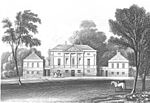Gidea Park railway station
DfT Category C2 stationsFormer Great Eastern Railway stationsLondon stations without latest usage statistics 1415London stations without latest usage statistics 1516London stations without latest usage statistics 1617 ... and 5 more
Rail transport stations in London fare zone 6Railway stations in Great Britain opened in 1910Railway stations in the London Borough of HaveringRailway stations served by the Elizabeth lineUse British English from August 2012

Gidea Park railway station is on the Great Eastern Main Line, serving the neighbourhood of Gidea Park in the London Borough of Havering, east London. It is 13 miles 41 chains (21.7 km) down the line from London Liverpool Street and is situated between Romford and Harold Wood. Its three-letter station code is GDP and it is in Travelcard zone 6. The station is currently managed by Transport for London and is on the Elizabeth line between Shenfield and London Paddington.
Excerpt from the Wikipedia article Gidea Park railway station (License: CC BY-SA 3.0, Authors, Images).Gidea Park railway station
Station Road, London Gidea Park (London Borough of Havering)
Geographical coordinates (GPS) Address Nearby Places Show on map
Geographical coordinates (GPS)
| Latitude | Longitude |
|---|---|
| N 51.582 ° | E 0.2063 ° |
Address
Platform 2
Station Road
RM2 6BX London, Gidea Park (London Borough of Havering)
England, United Kingdom
Open on Google Maps






